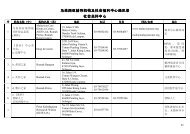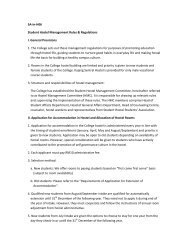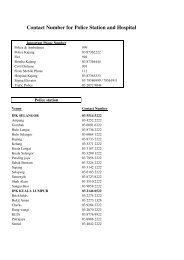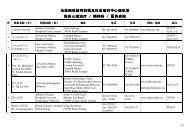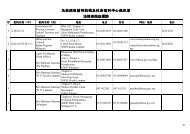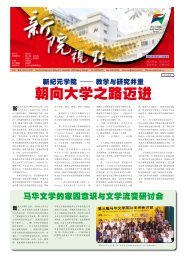colonial image of malay adat laws: a critical appraisal ... - 新纪元学院
colonial image of malay adat laws: a critical appraisal ... - 新纪元学院
colonial image of malay adat laws: a critical appraisal ... - 新纪元学院
You also want an ePaper? Increase the reach of your titles
YUMPU automatically turns print PDFs into web optimized ePapers that Google loves.
<strong>新纪元学院</strong>学报<br />
2009年,第六期,页139-142<br />
New Era College Academic Journal<br />
Vol.6 (2009), pp.139-142<br />
<strong>colonial</strong> <strong>image</strong> <strong>of</strong> <strong>malay</strong> <strong>adat</strong> <strong>laws</strong>: a <strong>critical</strong><br />
<strong>appraisal</strong> <strong>of</strong> Studies on <strong>adat</strong> <strong>laws</strong> in the <strong>malay</strong><br />
Peninsula during the <strong>colonial</strong> era and Some<br />
continuities<br />
徐玉燕(<strong>新纪元学院</strong>马来西亚族群研究中心研究员)<br />
CHEE Nyuk Yan (Researcher cum Lecturer, Malaysian Centre for Ethnic Studies,<br />
New Era College)<br />
Noor Aisha Abdul Rahman, Colonial Image <strong>of</strong> Malay Adat<br />
Laws: A Critical Appraisal <strong>of</strong> Studies on Adat Laws in the Malay<br />
Peninsula during the Colonial Era and Some Continuities, United<br />
States: Brill Academic Publishers, 2006.<br />
“Colonial Image <strong>of</strong> Malay Adat Laws: A Critical Appraisal <strong>of</strong><br />
Studies on Adat Laws in the Malay Peninsula during the Colonial<br />
Era and Some Contimuities” is an academic book written by Noor<br />
Aisha Abdul Rahman and published by Brill Academic Publisher.<br />
It explores the following issues: the <strong>colonial</strong> perceptions <strong>of</strong> Malay<br />
<strong>adat</strong> <strong>laws</strong>, problems concerning the conceptualization <strong>of</strong> Malay<br />
<strong>adat</strong> <strong>laws</strong>, Islam and its relationship with Malay <strong>adat</strong> <strong>laws</strong>, <strong>adat</strong> land and inheritance law,<br />
Malay rulers and Malay <strong>adat</strong> <strong>laws</strong>.<br />
Due to the tension between western world and the Muslims, Islamization becomes an<br />
important academic issue in recent years. In this groundbreaking book, Noor Aisha aims to give<br />
a <strong>critical</strong> <strong>appraisal</strong> <strong>of</strong> the studies on Malay <strong>adat</strong> <strong>laws</strong> in the Malay Peninsula by authoritative<br />
<strong>colonial</strong> administrators and scholars. Through analyzing dominant representations <strong>of</strong> Malay<br />
<strong>adat</strong> <strong>laws</strong> and Islamic <strong>laws</strong>, she intends to clarify some misconceptions about these two <strong>laws</strong><br />
and rejects the hegemony <strong>of</strong> western epistemology when dealing with Malay <strong>laws</strong>.<br />
During the <strong>colonial</strong> time, few <strong>colonial</strong> writers could take a holistic approach to Malay<br />
139
<strong>laws</strong> due to their ethnocentric attitudes. With the expansion <strong>of</strong> <strong>colonial</strong>ism, Orientalism has<br />
become a well-defined style for <strong>colonial</strong> scholars to classify and investigate types <strong>of</strong> knowledge<br />
within the conquered territories since the early 19th century. According to Noor Aisha,<br />
140<br />
As a style <strong>of</strong> thought, Orientalism is based upon a fundamental distinction between the west<br />
and the Orient in which the superiority <strong>of</strong> the West and the latter’s inferiority are unquestioned.<br />
This epistemological divide is inextricably tied to political domination and authority over the<br />
Orient creating a network <strong>of</strong> interests which inevitably penetrates perspectives and representations<br />
on any subject involving the Orient such that what emerges is a certain consistency <strong>of</strong> ideas. 1<br />
She believes that due to the superiority <strong>of</strong> western political power and ethnocentric attitude,<br />
the <strong>colonial</strong> administrators and scholars always carry bias and prejudice when dealing with<br />
Malay <strong>adat</strong> <strong>laws</strong>.<br />
She scrutinizes the works <strong>of</strong> John Crawford, Stamford Raffles, R.J. Wilkinson, R.O.<br />
Winstedt, E.N. Taylor, Josselin de Jong, Michael Peletz, W.E. Maxwell, F.A. Swettenham and<br />
Braddel Alatas, and <strong>critical</strong>ly examines and reveals their misconceptions and inadequacies.<br />
Melaka Legal Code (Undang-Undang Melaka), the Kedah Legal Code (Undang-Undang<br />
Kedah), the Minangkabau Digest from Perak, and the Sungei Ujong Legal Code (Undang-<br />
Undang Sugei Ujong) have been utilized as the primary sources to portray the Malay <strong>adat</strong><br />
<strong>laws</strong>.<br />
Adat Perpateh and Adat Temenggong are two different types <strong>of</strong> Malay <strong>laws</strong>. Colonial<br />
writers felt that the Adat Temenggong is largely influenced by Hinduism and Islam, however,<br />
they categorized the Adat Perpateh as the original Malay <strong>laws</strong> prior to the coming <strong>of</strong> Islam and<br />
Hinduism. From their point <strong>of</strong> view, Malay <strong>laws</strong> are backward and inadequate in dealing with<br />
social issues, and they see the coming <strong>of</strong> Islam as the main obstacle to the progress <strong>of</strong> Malay<br />
<strong>laws</strong>. They perceived Islam and Malay <strong>adat</strong> <strong>laws</strong> as irreconcilable and conflicting because<br />
Islamic <strong>laws</strong> originated from a different social context, so it could not practically serve the<br />
needs <strong>of</strong> the Malays. The <strong>colonial</strong> writers judged Islamic law as static and arbitrary and that it<br />
has a negative impact upon the traditional Malay <strong>laws</strong>.<br />
Through discussing the topics <strong>of</strong> Islam and its relationship with Malay <strong>adat</strong> <strong>laws</strong>,<br />
1 Noor Aisha Abdul Rahman, <strong>colonial</strong> <strong>image</strong> <strong>of</strong> <strong>malay</strong> <strong>adat</strong> <strong>laws</strong>: a <strong>critical</strong> <strong>appraisal</strong> <strong>of</strong> Studies on <strong>adat</strong> <strong>laws</strong><br />
in the <strong>malay</strong> Peninsula during the <strong>colonial</strong> era and Some continuities, United States: Brill Academic Publishers,<br />
2006, p. 3.
<strong>adat</strong> land and inheritance <strong>laws</strong>, Noor Aisha points out some significant problems in the<br />
conceptualization <strong>of</strong> Malay <strong>adat</strong> <strong>laws</strong> and Islam among the <strong>colonial</strong> writers. She criticizes that<br />
their works are full <strong>of</strong> bias and prejudice due to insufficient knowledge <strong>of</strong> both Islam and <strong>adat</strong><br />
<strong>laws</strong>. Their misconceptions prevented them to go further in understanding the relationship<br />
between Islam and Malay <strong>adat</strong> <strong>laws</strong>. For instance, the collusion <strong>of</strong> interest between <strong>colonial</strong><br />
rulers and <strong>colonial</strong> capitalists influenced their understanding on Malay land tenure. In order to<br />
deal efficiently with land issues, British <strong>colonial</strong> administrators adopted the “land belonged to<br />
the ruler” theory, in which they ignored the fact that the ruler is merely a trustee and custodian<br />
<strong>of</strong> the land, and that the Malays have a permanent and transmissible proprietary interest in the<br />
soil even if they have <strong>of</strong>fended the sultan and fled from the village.<br />
In dealing with the issues <strong>of</strong> Islam and its relationship with Malay <strong>adat</strong> <strong>laws</strong>, the <strong>colonial</strong><br />
writers subscribed to the view that Islam contradicts the Malay <strong>adat</strong> <strong>laws</strong>, because the Islamic<br />
<strong>laws</strong> are woven into Arabian or Middle Eastern practices which are different from the Malay<br />
cultural context. However, Noor Aisha asserts that “Islam accommodates customary <strong>laws</strong> so<br />
long as these are in consonance with its essential doctrine and principles.” 2 From Article 71 <strong>of</strong><br />
Undang-Undang Sungei Ujong:<br />
<strong>adat</strong> confirms religious law as is said in the hadith “… when <strong>adat</strong> has a strong position<br />
in a country, it serves as religious law”, for the strength <strong>of</strong> <strong>adat</strong> is based on the consensus <strong>of</strong><br />
all religious scholars and the Companions <strong>of</strong> the Prophet. For that reason, <strong>adat</strong> is strengthened,<br />
religious law is enforced, both are employed to the present day, unchanging down the generations,<br />
handed from our ancestors. 3<br />
Noor Aisha criticizes these <strong>colonial</strong> writers for having overlooked the mutual influence <strong>of</strong><br />
Islam and <strong>adat</strong> <strong>laws</strong>, and the dynamism and flexibility <strong>of</strong> the Islamic <strong>laws</strong> in dealing with<br />
social problems. The works <strong>of</strong> Michael G. Peletz have proven that Noor Aisha’s argument is<br />
correct.<br />
Peletz contends that the coming <strong>of</strong> Islam did not displace the <strong>adat</strong> in the consciousness <strong>of</strong><br />
the Malays but led to a selective syncretisation, which effectively linked the <strong>adat</strong> and Islam in<br />
such a manner as to preserve the entire realm <strong>of</strong> <strong>adat</strong>. 4<br />
2 Ibid., p. 52.<br />
3 Ibid., p. 52. Also, R.O. Winstedt and Josselin de Jong eds., “A Digest <strong>of</strong> Customary Law from Sungei Ujong”, in<br />
journal <strong>of</strong> the <strong>malay</strong>an Branch royal asiatic Society, Vol. XXVII, Part 3, July, 1954, pp. 51-52.<br />
4 Noor Aisha, op. cit., p. 113.<br />
141
Noor Aisha argues that these <strong>colonial</strong> writers ignored the fact that culture is always changing<br />
and adapting, thus “<strong>adat</strong> is in a process <strong>of</strong> gradual transformation in response to the changing<br />
requirement and consciousness <strong>of</strong> the people.” (Abdul Rahman, 2004:104) And, social<br />
and economic developments except Islam are the main factors, which cause the changing<br />
requirement and consciousness <strong>of</strong> the Malays.<br />
The works <strong>of</strong> <strong>colonial</strong> writers have been examined in detail throughout this book. Noor<br />
Aisha gives abundant evidence to support the essential elements <strong>of</strong> Malay <strong>adat</strong> <strong>laws</strong> and Islam.<br />
Through various historical documents and works <strong>of</strong> other <strong>colonial</strong> scholars, such as Michael<br />
G. Peletz, Noor Aisha tries to prove that <strong>adat</strong> and Islam are compatible in several aspects.<br />
However, the lack <strong>of</strong> real-life case study and instances is the main weakness <strong>of</strong> her work.<br />
Without practical case study, her work is only a superficial analysis and may fail to perceive<br />
the latent contradiction <strong>of</strong> Malay <strong>adat</strong> <strong>laws</strong> and Islam. A review <strong>of</strong> methodology and analysis<br />
<strong>of</strong> <strong>colonial</strong> writers can only reveal part <strong>of</strong> the truth about the relationship <strong>of</strong> Malay <strong>adat</strong> <strong>laws</strong><br />
with Islam.<br />
Moreover, Noor Aisha’s study lacks a comprehensive discussion on Malay <strong>adat</strong> <strong>laws</strong><br />
and Islam, as the studies on <strong>adat</strong> land and inheritance <strong>laws</strong> cannot give a comprehensive<br />
analysis <strong>of</strong> the relationship between Malay <strong>adat</strong> <strong>laws</strong> and Islam. For example, we can find<br />
some contradictory phenomena in Malay society through gender issues. Makiko Hanami, an<br />
anthropologist who did her research in Kelantan from 1984 to 85 and from 1996 to 97, found<br />
that there is a tension between the formal and informal dimension in Malay society. According<br />
to Makiko Hanami’s study, Islam governs the formal dimension <strong>of</strong> Malay life, whereas, the<br />
traditional and informal dimension are based on <strong>adat</strong> values. 5 Likewise, according to sociology<br />
pr<strong>of</strong>essor Lau-Fong Mak, Islamic interpretations make Malay women inferior to men, but<br />
Malay women are regarded equal in Malay <strong>adat</strong> <strong>laws</strong>. 6<br />
In summary, the book challenges the idea that the relationship between <strong>adat</strong> law and<br />
Islam is irreconcilable and conflicting. Although Noor Aisha reveals part <strong>of</strong> the truth through<br />
discussing the topic <strong>of</strong> Adat land and inheritance <strong>laws</strong>, her study is inadequate to provide a<br />
comprehensive view <strong>of</strong> the relationship between Malay <strong>adat</strong> <strong>laws</strong> and Islam without discussing<br />
gender issues. However, this book provides valuable insights into the relationship <strong>of</strong> Malay<br />
<strong>adat</strong> <strong>laws</strong> and Islam; it also criticizes the ethnocentric attitudes <strong>of</strong> <strong>colonial</strong> scholars.<br />
5 Makiko Hanami, gender in rural <strong>malay</strong> community: Between <strong>adat</strong> and islam, Los Angeles: University <strong>of</strong><br />
California, 2002, p. 267.<br />
6 Mak Lau-Fong, islamization in Southeast asia, Taiwan: Academia Sinica, 2002, p. 51.<br />
142



